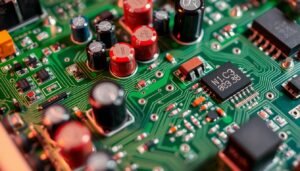Introduction
Within the complex realm of electronic circuit design, the process of component selection transcends mere mundaneness akin to compiling a grocery list. Rather, it entails a deft finesse that strikes a balance between cost, efficiency, and performance. An optimal component selection can significantly enhance the efficacy of a circuit, whereas an unsuitable option may result in inadequate operation or complete failure.
This blog explores the crucial procedure of optimizing the selection of electronic components in order to guarantee that circuits operate with optimal efficiency and dependability.
Comprehending Circuit Prerequisites
The Importance of Specifications
Prior to commencing component selection, it is imperative to acquire a comprehensive understanding of the project’s specifications. Environmental conditions, frequency range, power consumption, and operating voltage and current are all included. These parameters establish the framework for identifying components that satisfy or surpass the specified criteria.
Cost-efficiency and Performance Equilibrium
Efficiency encompasses not only technical performance but also cost-effectiveness. An essential element of effective circuit design is achieving an optimal equilibrium between budgetary limitations and high-quality components.
Choosing the Appropriate Components
Capacitors and resistors
The selection of capacitors and resistors is crucial. Significant roles are played by tolerance, power rating, and temperature coefficient in determining the efficacy and stability of a circuit. When designing a circuit, choose components that offer optimal performance while adhering to the environmental and electrical limitations.
ICs and transistors constitute integrated circuits.
ICs and transistors comprise the core of numerous circuits. Power dissipation, switching speed, and gain are all parameters to consider when choosing these components. Integrated functionalities provided by advanced ICs can decrease circuit complexity and increase efficiency.
Cables and connectors
Constantly disregarded, cables and connectors are indispensable for dependable interconnections. For optimal signal integrity, select connectors that meet the mechanical and electrical specifications of your application, as well as cables with suitable shielding and conductor materials.
The Significance of Reliability and Quality
Selecting Reliable Producing Companies
The caliber of components can determine the success or failure of a circuit. Selecting components from well-regarded manufacturers guarantees dependability and adherence to industry norms.
Comprehending the MTBF and Lifecycle
Component lifecycle and Mean Time Between Failures (MTBF) should be taken into account. By opting for components that possess extended lifespans and higher reliability ratings, one can substantially improve the overall efficiency and durability of the circuit.
Managing the Issue of Obsolescence
Electronic components are susceptible to rapid obsolescence. Make provisions for the future by selecting components that possess readily available alternatives or are anticipated to remain available throughout the lifecycle of your product.
Adjustments Particular to High-Frequency Circuits
Noise and interference reduction
In high-frequency circuits, interference and noise minimization are of the utmost importance. In addition to promoting the selection of components characterized by low parasitic capacitance and inductance, one should contemplate the architecture of the printed circuit board in order to mitigate cross-talk and electromagnetic interference.
Thermal Administration
High-frequency components are capable of producing considerable amounts of heat. By selecting components and designing circuits in a manner that effectively manages temperature, it is possible to prevent overheating and guarantee stable operation.
The augmentation of signal integrity
Signal integrity is of the utmost importance in applications involving high frequencies. Signal quality must be preserved by ensuring that components are chosen with the proper bandwidth and minimal distortion.
Making Power Efficiency Optimal
Components of power management infrastructure
When considering power efficiency in circuits, it is critical to select the appropriate power management components, such as power MOSFETs and voltage regulators. To reduce power losses, choose components with low quiescent current and high efficiency.
Energy storage and harvesting
When considering energy harvesting applications, it is crucial to choose components that optimize energy conversion and storage efficacy. This may involve capacitors and specialized integrated circuits intended for energy-harvesting applications.
The mitigation of standby power consumption
Standby power consumption can constitute a substantial portion of the energy footprint of a circuit. Choose components with minimal standby power consumption in order to improve energy efficiency overall.
What the Future Holds for Component Selection
Emerging technologies are being discussed.
Remain informed regarding emergent electronic component technologies. Ongoing progress in the fields of materials science and manufacturing techniques presents novel prospects for enhancing the efficacy of circuits.
Predictive simulation and modeling
The application of simulation and predictive modeling tools can facilitate the selection of the most suitable components for a given circuit. By enabling you to predict the performance of components under different conditions, these instruments facilitate the selection process.
Tailored Component Solutions
Custom component solutions may be the most efficient option in certain circumstances. Cooperating with manufacturers to design and fabricate components that are customized to meet your particular requirements can yield substantial improvements in performance.
Conclusion
A process as complex as selecting the appropriate electronic components necessitates an in-depth knowledge of both the specifications of the circuit and the capabilities of the components that are available.
You can maximize the efficacy and dependability of your circuit by conducting a thorough analysis of performance, cost, quality, and future-proofing options. Sustaining awareness and flexibility will be crucial in navigating the dynamic realm of electronic components as technology persistently progresses. Keep in mind that the smallest components can have the greatest impact in the world of electronics.
